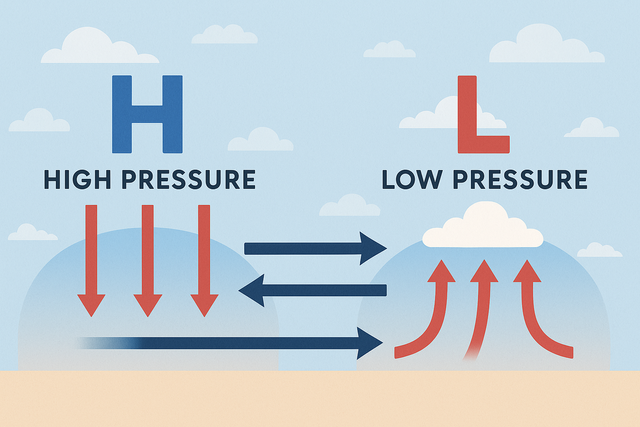Air Pressure Explained Like You're 5
Understanding Air Pressure Made Simple
Air pressure is one of those things in weather and climate that can be pretty confusing at first — but let me break it down for you.
Air pressure is basically the force that air molecules apply vertically on any surface due to Earth's gravity. So, high pressure means there are a lot of air particles pushing downward, while low pressure is where fewer particles are pushing down — it’s like the air is lighter and rising.
Now, how does pressure move?
High pressure always flows toward low pressure. This creates wind.
If the pressure difference is big, you get strong winds. If the difference is small, you just get a gentle breeze.
A Real Example: Sea Breeze in Alexandria
Let’s take Alexandria in Egypt during summer as an example.
In summer, there's something called a sea breeze. It happens because the sun heats up land (the ground) faster and more intensely than it heats up water.
As a result, the air above the land gets warmer, rises, and creates low pressure. Meanwhile, the air above the sea stays cooler and sinks — that’s high pressure.
When the land gets hot enough and the pressure drops more, the cooler air over the sea starts to move in to replace it — that’s the sea breeze you feel, especially in the late afternoon.
At night, the situation flips — the land cools down faster than the sea, so the air pressure over the land becomes higher than over the sea. Air now moves from land to sea, and this is called a land breeze.
So, what are the characteristics of each pressure system?
High Pressure:
Air moves downward from the upper atmosphere
It stops clouds from forming (because the air is sinking, not rising)
The weather is usually stable and dry
Temperatures are often higher
Low Pressure:
Air rises from the surface into the upper atmosphere
Helps clouds to form if there’s enough heat and humidity
The weather is usually unstable — cloudy, rainy, and sometimes stormy
Question: If summer heat causes low pressure, why doesn’t it rain in Egypt — especially Alexandria?
Well, in Egypt, summer air is typically very dry, so there’s not enough moisture to form clouds, even if the pressure is low.
Even in coastal cities like Alexandria, which are more humid, a subtropical high-pressure system dominates during summer.
This system comes from the equator, India, or the Gulf region, and it acts like a big hot “lid” in the upper atmosphere. It blocks strong low-pressure systems from moving in, and because the air above is hot, it makes it really hard for clouds to form or for any storms to develop — even from the north or Europe.
What exactly is a low-pressure system, and how is it connected to storms?
Imagine a circle where the center is the lowest pressure point — that means warm air is rising there, creating clouds.
Since the center has the lowest pressure, surrounding areas (with higher pressure) push air toward it. This inflow of air creates wind that rushes in.
As warm, moist air rises and cools, it condenses into clouds. If this continues, a storm can form.
The bigger the pressure difference between the center and the surroundings, and the slower the system moves, the stronger and longer the storm will be.
But wait — why doesn’t the storm just stop once cold air enters and hot air rises?
There are many reasons, but one big one is that the incoming cold air might be heavier, or there’s still warm air left in the area.
In Egypt, for example, it’s often sunny even in winter — so warm air continues to rise, clouds keep forming, and the storm continues.
Why do these storms mostly affect the northern coast more than the rest of Egypt?
Because of humidity.
High humidity near the coast helps clouds form faster. In other parts of Egypt, once the cold air enters and pressure balances out, the storm quickly fades because the air is dry.
But along the coast, humidity stays high, and it’s the first place where cold fronts from Europe or the Mediterranean hit — that’s why storms are more frequent there.
There are other factors too, like the jet stream, but that’s a whole topic for another post.
Quick Recap:
High pressure = cooler, heavier air sinks → stable weather, clear skies, less cloud formation
Low pressure = warmer, lighter air rises → clouds form, and if the right conditions are there (heat + humidity), you get unstable weather, wind, and sometimes storms
